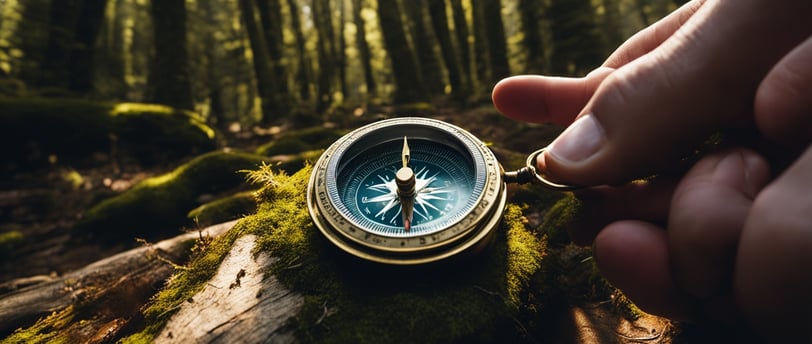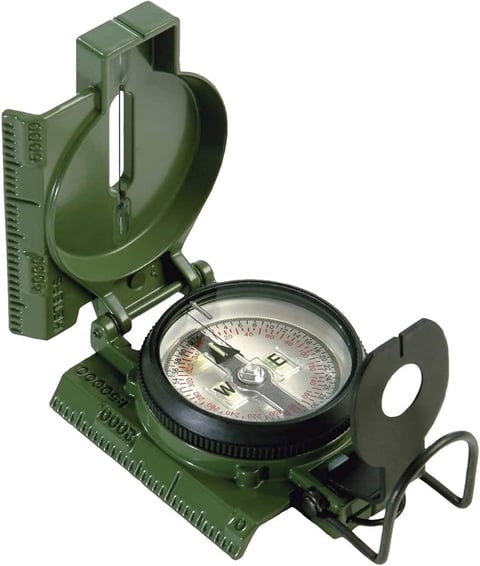Mastering Your Survival Compass: Essential Tips
Learn how to navigate the wilderness confidently with a survival compass. Master essential skills to find your way, even when technology fails.
The Bug Out Bunker
8/26/202411 min read


I've been in the woods when the sun dips low, and every tree starts to look the same. It's a gut-wrenching feeling. But I've learned that a survival compass can be your best friend in these situations. It's a simple tool that can guide you back to safety, even when your phone's dead and you're miles from anywhere.
Knowing how to use a survival compass is crucial for anyone who loves the outdoors. It's not just about avoiding getting lost; it's about having the confidence to explore further and push your limits. In this guide, I'll share my tips on compass navigation techniques and using a compass in the wilderness.
Whether you're a seasoned hiker or just starting out, mastering your survival compass can make all the difference. It's a skill that could save your life one day. So let's dive in and learn how to make this simple tool work for you in any situation.
Key Takeaways
A survival compass is essential for wilderness navigation
Basic compass skills can be lifesaving in emergency situations
Compass navigation techniques work without batteries or cell signal
Ruler compasses are recommended for beginners
Practice compass skills before venturing into unfamiliar terrain
Understanding the Importance of a Survival Compass
A survival compass is key for anyone heading into the wild. It's my top choice for precise navigation, no matter the weather or location. Unlike GPS, it doesn't need batteries, making it a trusted ally in tough times.


When I'm lost, my compass is my guide. It shows me the way and helps me find a safe path back. Knowing how to use a compass and plan is vital for surviving outdoors. These skills help me navigate tough terrains and avoid dangers.
What makes a survival compass so versatile is its adaptability. I can use it with or without a map, depending on what I have. This has saved me many times when exploring new places or facing unexpected challenges in the wild.
"A compass is a small investment that can make a big difference in your outdoor safety and confidence."
Learning to use a survival compass is a basic skill for outdoor lovers. It's not just about getting from point A to B; it's about feeling confident in navigating and surviving in nature. Whether you're an experienced hiker or a casual camper, knowing how to use a compass can change a crisis into a manageable challenge.
Components of a Survival Compass
Knowing how a survival compass works is key to using it right. Let's look at the main parts that make up a survival compass.
Baseplate and Direction of Travel Arrow
The baseplate is the clear base of the compass. It has straight edges for lining up with map lines. There's also a direction of travel arrow that shows where you're headed. This arrow is super useful when you're navigating hard terrain.
Rotating Bezel and Degree Markings
The rotating bezel goes around the compass housing and has 360 degrees marked on it. By turning this bezel, I can set my course. The degree markings help me navigate with precision and read bearings accurately.
Magnetic Needle and Orienting Arrow
The magnetic needle is the compass's core. It always points to magnetic north, guiding me. The orienting arrow, fixed inside the compass, helps line up the magnetic needle with north on the bezel. This is crucial for setting correct bearings.
Understanding these parts has made me a better navigator. With practice, reading compass bearings becomes easy. This skill makes outdoor adventures and survival situations better.
How to Use a Survival Compass
Learning how to use a compass is key for outdoor survival. I'll show you the basics of setting your course and following a bearing with a survival compass.
Setting the Compass
First, place your compass flat on the map. Make sure its edge lines up with your starting and ending points. Turn the compass housing until the lines match the map's north-south lines. This is important for planning your trip.
Taking a Bearing
With your compass set, it's time to take a bearing. Hold the compass level at chest height. Turn your body so the magnetic needle points to the orienting arrow in the compass. The direction arrow will now show where you're going. This is a basic but crucial skill.
Following a Bearing
To follow your bearing, keep the compass level and the needle in line with the orienting arrow as you walk. Look for a landmark in the distance and head towards it. Keep doing this to stay on track. Remember, the more you practice, the better you'll get.
"The compass is your lifeline in the wilderness. Master its use, and you'll never truly be lost."
Mastering these steps will help you navigate tough terrains. Remember, practicing these compass skills is key to gaining confidence in your survival abilities.


Navigating with a Map and Compass
I love exploring the great outdoors. Learning compass navigation techniques has changed my adventures. It's key to know how to use a compass with a map.
First, I put my compass on the map and line it up with where I am and where I'm going. Then, I turn the compass until the lines match the map's north-south lines. This makes sure I know the right direction.
One trick I use is called "boxing." If I hit a roadblock, I turn 90 degrees at each corner to keep on course. This way, I avoid dangers while staying on track.
Remember: The map is your window to the landscape, and the compass is your guide through it.
Getting better at this takes practice. I set up mock navigation challenges in local parks. Over time, using a compass with a map becomes easy. This lets me explore even the wildest places with confidence.
Always carry a reliable map and compass
Practice orienting your compass regularly
Learn to identify landmarks for better navigation
With these tools and skills, I can navigate tough terrain with ease. This lets me fully enjoy the adventure.
Understanding Declination and Making Adjustments
Using a magnetic compass isn't always easy. To navigate well, I must understand declination and adjust correctly. Let's explore this key part of compass use.
What is Magnetic Declination?
Magnetic declination is the difference between true north and magnetic north. This difference changes based on where I am and over time. It's key to consider this when using a compass.
How to Adjust for Declination
To fix for declination, I add or subtract the declination angle from my compass reading. A simple way to remember this is: "Maps Tell Almost Everything" - Magnetic to True, Add East. If my area has eastern declination, I add the angle to my reading.
Using Online Tools for Declination Information
Online tools are great for getting the latest declination info for my area. They give me precise data, making sure my compass is set right. By learning and adjusting for declination, I boost my navigation skills with a magnetic compass.
"Proper compass declination adjustment is the key to accurate navigation in the wilderness."
A small mistake in declination can cause big navigation errors over long distances. That's why I always check my declination before heading out on an adventure.
Types of Survival Compasses
Choosing the right compass is key for navigating the wilderness. Different compasses are made for different needs.
Baseplate compasses are great for map work. They're easy to use and help me plot my path. The Suunto M-3 NH is a top choice. Its clear baseplate makes it easy to see the map while I plan my route.
Lensatic compasses give me precise readings. Cammenga Official US Military is a favorite among those in the military. It's a bit more complex but offers unmatched accuracy in the wilderness.
Button compasses are small but powerful. They're simple, but I always carry one as a backup. They're perfect for quick checks of direction in well-marked areas.
Baseplate compasses: Best for map work
Lensatic compasses: Highest precision
Button compasses: Compact backup option
Each compass type has its own benefits. I pick based on what I need for my trip. For deep backcountry trips, I bring both a baseplate and a lensatic compass. This way, I'm ready for any navigation challenge the wilderness brings.
Advanced Compass Navigation Techniques
Learning advanced compass navigation is key for outdoor enthusiasts. These skills help you avoid getting lost and stay safe.
Triangulation
Triangulation is a method I use to find my location. I take bearings from three landmarks and plot them on a map. This way, I can pinpoint my exact spot, even in unknown areas.
Terrain Association
Terrain association means matching what I see with my map. I look for landmarks like rivers and hills. This skill keeps me on track and confirms my location as I move through the wilderness.
Night Navigation
Navigating at night is tough. I use the North Star and a red-light headlamp to help. With practice, these techniques become easy, even in the dark.
"The wilderness is a great teacher. Every time I venture out, I learn something new about compass navigation."
Practicing these skills has boosted my confidence in using a compass outdoors. Remember, practice is essential for mastering these techniques. It ensures safe navigation in any outdoor adventure.
Common Mistakes to Avoid When Using a Survival Compass
When using a compass in the wilderness, it's key to avoid common errors for successful navigation. Let's look at some frequent mistakes and how to avoid them.
One big mistake is not aligning the compass with the map correctly. I always double-check that my compass is properly set before I take a bearing. This simple step can prevent hours of walking in the wrong direction.
Another mistake is not adjusting for declination. I always remember to account for the difference between magnetic and true north. This small step is crucial for accurate navigation.
Holding the compass incorrectly
Navigating near metal objects
Forgetting to level the compass
These are mistakes I've seen while fixing compass problems. Holding the compass flat and away from metal objects lets the needle move freely. I always make sure my compass is level before reading it.
Remember, practice makes perfect. The more you use your compass, the fewer mistakes you'll make.
Being aware of these errors and practicing proper use has greatly improved my navigation skills. It's all about focusing on details and building good habits with your compass in the wilderness.
Maintaining and Caring for Your Survival Compass
Keeping your compass in good shape is key for wilderness use. I've found that proper care makes it reliable when you really need it. Here are some key tips to keep your compass working well.
Cleaning and Storage
I clean my compass with mild soap and water after each use. It's crucial to dry it well to avoid moisture damage. I store it in a protective case away from magnets. This keeps it accurate and extends its life.
Checking for Accuracy
It's important to check your compass often for accuracy. I compare it to known landmarks or bearings. If it's off, I double-check it. This ensures I can rely on it in the wilderness.
When to Replace Your Compass
Compasses don't last forever, even with good care. I replace mine if it's damaged or gives wrong readings. Signs like bubbles in the liquid or a stuck needle mean it's time for a new one. Remember, your compass could be a lifesaver, so replace it when needed.
"A well-maintained compass is your lifeline in the wilderness. Treat it with care, and it will guide you home."
By following these tips, I make sure my compass is always ready for adventure. Regular care not only makes it last longer but also gives me confidence when I'm in the wild.
Conclusion
I've looked into how to use a survival compass and why it's so important for outdoor lovers. Knowing how to use a compass can really change the game when you're lost in the wilderness. It covers everything from the basics to advanced techniques, making you a confident explorer.
Practice is key. The more you use your compass, the easier it gets. I suggest practicing with your compass on short hikes in places you know well before tackling tougher areas. This will help you get better at using the compass.
As you get better, remember to take care of your compass and avoid mistakes. A well-maintained compass is a great friend for your outdoor adventures. By learning these skills, you're not just using a compass; you're learning to explore safely and handle surprises easily.
FAQ
Why is a survival compass important?
A compass is key for navigating the wilderness. It works without batteries and in all weather. It's vital for outdoor survival and can save lives in emergencies.
What are the main components of a survival compass?
A modern compass has several important parts. These include a transparent baseplate with edges and lines, a compass housing with 360° markings, and a magnetic needle that points to north. It also has an orienting arrow, a rotating bezel, an index line, and a direction of travel arrow.
How do I use a survival compass effectively?
First, place the compass edge on your starting and ending points on the map. Then, turn the compass housing so the orientation arrow points to north on the map. Next, turn yourself in the direction the needle shows, keeping the needle aligned with the arrow. Finally, follow the direction arrow to your destination.
How do I navigate with a map and compass?
Start by finding your location on the map. Then, set your compass direction from your starting point to your destination on the map. Make sure the orientation lines match the map's north-south lines, and read the compass bearing.
What is magnetic declination, and why is it important?
Magnetic declination is the difference between true north and magnetic north. It changes with location and over time. To navigate right, adjust your compass for declination by adding or subtracting the declination angle from your compass bearing.
What are the different types of survival compasses?
There are several types, like baseplate compasses, lensatic compasses, and simple button compasses. Baseplate compasses, like the Suunto M-3 NH, are versatile. Lensatic compasses, such as the Brunton Model 9077, are long and accurate. Button compasses are simple for finding directions in well-marked areas.
What are some advanced compass navigation techniques?
Advanced techniques include triangulation to find your location with landmarks, terrain association to match map features with the landscape, and night navigation using the stars.
What are some common mistakes to avoid when using a survival compass?
Avoid misaligning the compass with the map, forgetting to adjust for declination, holding the compass wrong, and navigating near metal objects that affect the needle.
How do I maintain and care for my survival compass?
Keep your compass clean and store it away from magnets. Clean it with mild soap and water. Use a protective case and check its accuracy often. Replace it if it's damaged or always off.
Source Links
Further reading
Thanks and best regards
The Bug Out Bunker
Visit the link below and Purchase your own Cammenga Official US Military Phosphorescent Lensatic Compass
This post may contain affiliate links. If you make a purchase through one of these links, we may earn a small commission at no additional cost to you. We only recommend products and services that we have personally used and believe will add value to our readers. Your support helps us continue to provide valuable content. Thank you for your support!


Survival
Stay prepared for any scenario with our expert insights.
© 2024. All rights reserved.
